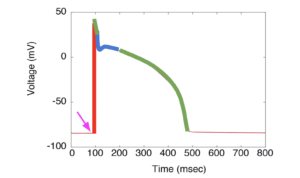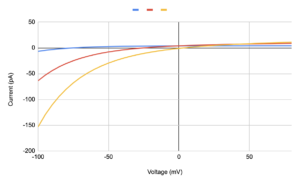And so comes to an end one of the greatest academic experiences of my life thus far. These six weeks have given me more than I could ever hope to achieve in relation to the pursuit and attainment of scientific knowledge.
We began this week by meeting another group of students and teachers. The lab that we would be working in was run by Professor Colleen Clancy, whom we were introduced to on Monday. We were also joined by five UC Davis students who are at various stages of their studies. Mr. John Dawson, whom we had been working with for two weeks prior, was one of the mentoring students who worked with us.
This week we mostly focused on the currents running in and out of cardiac cells as the cells depolarize and repolarize. This phenomenon, when working correctly, causes the heart to beat at a healthy rhythm. If even the slightest changes occur, the heart can be put off rhythm causing a condition known as Cardiac Arrhythmia.
In order to study the currents that pass in and out of the cardiac cells, we were taught to visualize cells as circuits that can transport ions of various elements, mainly sodium and potassium. Sodium transportation prompts rapid depolarization while Potassium prompts more gradual repolarization. ‘Gradual’ is a relative term, though, as this process takes place over the course of a few nanoseconds. Below is a picture of a relatively standard polarization cycle:
We were given equations to calculate the different currents that pass in and out of the cells as ions were artificially inserted in them. This experiment is known as “Patch Clamp” and provides valuable information regarding the behavior of the cardiac cells that have varying degrees of polarization. We ran a computer program that calculated an output for each 5-volt interval from -100 to 80 mV. We were then able to paste our results from the test into a spreadsheet and graph the values on a 3-line graph. I posted my graph below:
The tests that we ran through the computer yielded results that would be impossible to replicate through analog experimentation. The implementation of technology into the field of medicine and biology has advanced peoples’ ability to analyze and understand many areas that were previously incomprehensible before.
In my spare time, I have been taking every possible opportunity to visit with my friends because I’ll be leaving Colorado this Sunday to travel across the country in a van with my parents. I’ve spent each evening watching movies, going on walks, and having picnics with many amazing people (Socially distanced and within health parameters).
As my internship comes to a close, I know that this journey into the realm of scientific exploration is far from over for me. I plan to attend university studying architectural engineering and use my love for mathematics and design to help invent easily constructed and carbon-neutral homes for people around the world. I know that the knowledge I gained during this internship will reveal itself in a multitude of unexpected places in my future. And a few expected places as well, as I will continue working in Professor Yarov-Yarovoy’s lab generating protein models for the remainder of this summer upon his invitation. I am so excited to continue working with the incredible people I met in the past weeks. Speaking of amazing people:
No words in this language of ours can accurately describe the gratitude that I feel toward everyone who devoted their time and effort into my education as well as that of my peers. I learned how absolutely wonderful an experience can be with people who share a common enthusiasm for the theme. The fortune that was bestowed upon me in the form of mentors is beyond anything I could have ever fathomed before participating in this internship. I realize now because of my 6 weeks working with graduate students and professors from the UC Davis School of Medicine that the field in which one is engaged is only one component of the experience. The other and arguably more important component is the other people learning and advancing in the field alongside oneself.
Thank you so much to everyone who helped me on this incredible journey: every professor and student from UC Davis who welcomed me and taught me more about molecular biology than I could ever have imagined in just six short weeks, every high school student who took this trip with me, and, of course, thank you to the coordinators at Pinhead for making this all possible.



There are no comments published yet.